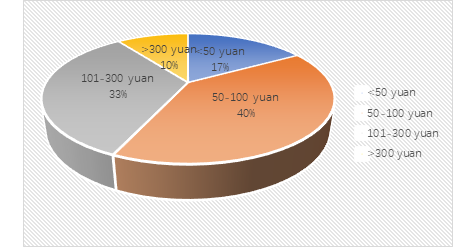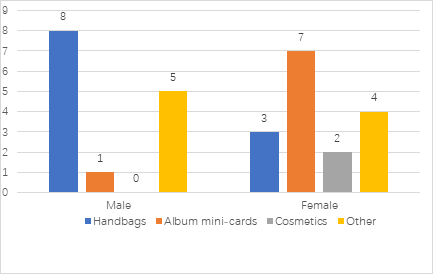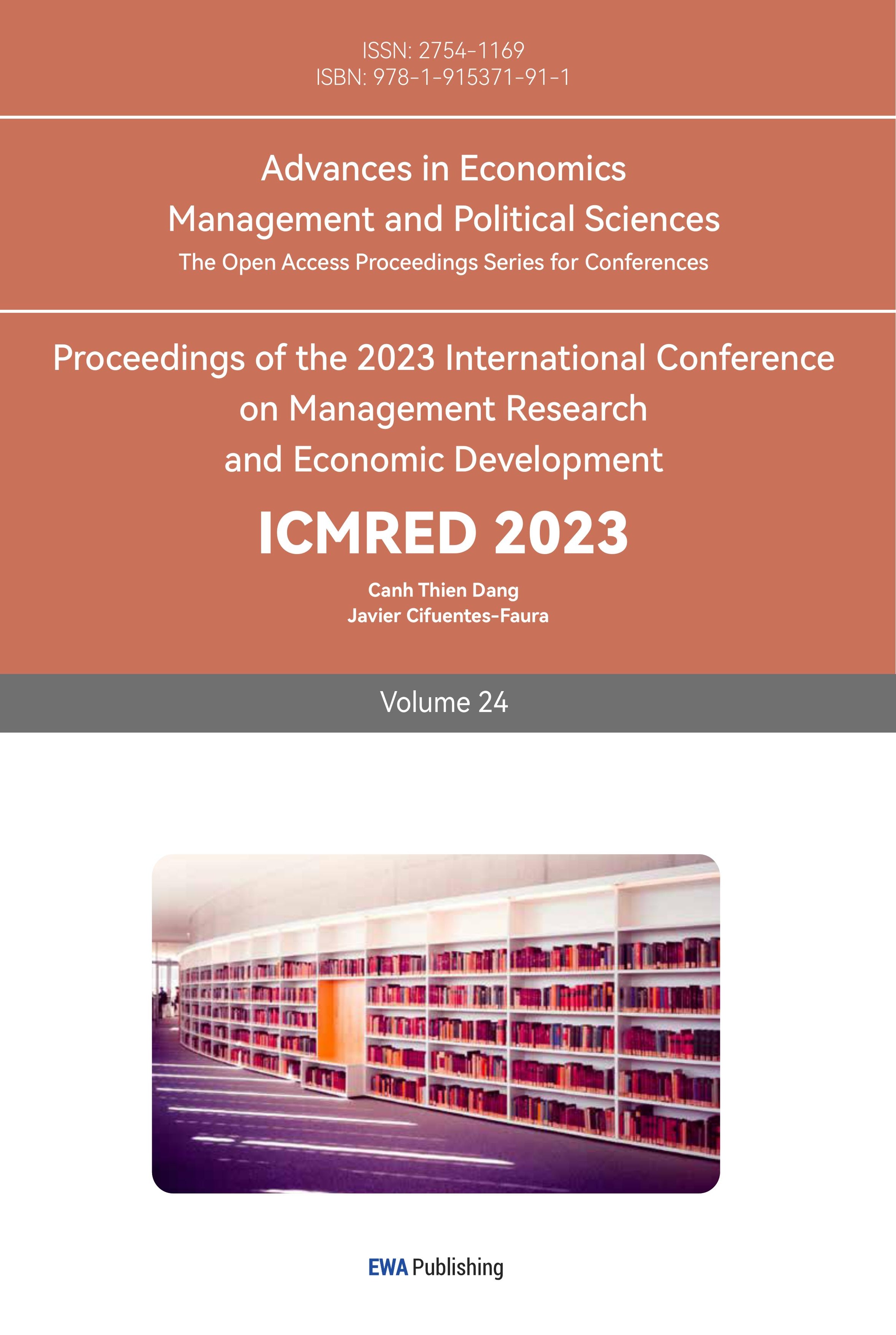1. Introduction
Blind boxes refer to toy boxes where consumers cannot know the specific product style in advance. The original name of this trendy toy was mini figures, which became popular in Europe and the United States and later became known as a blind box. It contains different styles of dolls in the same packaging box. Because the box is opaque, only when opened can you know what is inside. What the buyer draws depends on luck and has a random attribute, so it is called a blind box. The blind box originated from the lucky bag game launched by Japanese department stores. Merchants put multiple products into cloth or paper bags for low-cost matching sales, initially to clear inventory. In 2019, the popularity of blind boxes became a common economic phenomenon, leading to the emergence of the term "blind box economy" [1].
The market of blind box is increasingly large, leading the development of tide play. The blind box is usually filled with anime, film and television works around, or the designer separately designed dolls. The reason it is called a blind box is because the box is not marked, and only when it is opened will you know what you have drawn. Psychological research shows that uncertain stimuli will strengthen the repetition of decisions, so a blind box has become an addictive existence [2].
Those young people who are influenced by film and animation culture have relatively stronger purchasing power, but the dominant factors influencing consumers to purchase blind boxes are not yet clear, and this study investigates and researches this topic.
2. The Dominant Factors Influencing Consumers to Buy Blind Boxes
The dominant factors influencing consumers to buy blind boxes are divided into two major factors: the product itself and consumer emotion.
The product itself is divided into: the type of items inside the blind box(including the appearance of item, non-essential items especially PoP-Mart action figures), type, popularity and price.
Consumer emotions are divided into: seek novelty (curiosity about the unknown products inside the blind box), gambler's mentality (from gambling alone, it is to lose and want to win back the lost, win and want to continue to win, so that their own possessive desire to be further satisfied.), Krypton gold psychology (an operational conditioning reflex. If consumers spend more money, they will get more of what they want. Some consumers even buy the full series.), pleasure (the pleasure and excitement of the process by opening a blind box, which is time-sensitive. The pleasure of getting the blind box you like.).
2.1. Assumptions
For single/few-time blind box purchasers, the dominant factor influencing their initiation of blind box purchases was the type of items inside the blind box.
For consumers who buy blind boxes multiple times, the dominant factor that influences them to continue buying multiple times is gambler's mentality.
The consumer's gambling mentality is heavy, and the possibility of choosing to buy hidden editions of figures blind boxes is high.
2.2. Method
The hypothesis comparison method was used to design the questionnaire for the above three hypotheses. Since the above three hypotheses are mainly related to the figure type blind box, the survey questionnaire is also designed for the creature figures blind box with hidden editions. The survey subjects were classmates, parents, friends and relatives, aged 12-55 years old. The experimental data was obtained by distributing and collecting questionnaires. 50 questionnaires were distributed at 18:00 on February 22, 2023, all electronically. 50 questionnaires were collected by 18:00 on February 24, 2023, and all options were scored as valid questionnaires. The questionnaire data were entered into an Excel sheet, and the mean was calculated and compared for analysis.
See Appendix for the survey questionnaire.
2.3. Results
In this study, 50 questionnaires were sent and a total of 30 valid questionnaires were collected. The age of the questionnaire collected ranged from 14 to 51 years old, with 2 people aged 14-15 years old, 19 people aged 15-18 years old, 5 people aged 18-25 years old, 3 people aged 26-35 years old, 0 people aged 36-45 years old, and 1 person aged 46 and above. The main population was 15-25 years old (24 people, accounting for 80%). Among them, there are 14 males, accounting for 46.7%, and 16 females, accounting for 53.3%. In the educational background composition of the questionnaire, 21 people with high school or below degrees, accounting for 70%, 6 people with college or undergraduate degrees, accounting for 20%, and 3 graduate students, accounting for 10%. The occupational composition shows that there are 26 students, accounting for 86.7%, 1 enterprise personnel, accounting for 3.3%, and 3 public institution personnel, accounting for 10%. The monthly consumption of blind boxes in the questionnaire is shown in Figure 1. The highest proportion (40%) is between 50 and 100 yuan per month, and the proportion of monthly consumption between 101 and 300 yuan per month is 33.3%. Most people (25, 83.3%) have been exposed to blind boxes for more than 3 years. In which type of blind box products to purchase, men and women showed different tendencies (see Figure 2). Men were more likely to purchase hand-held blind box products (8, accounting for 57.2%), and women were more likely to purchase album cards (7, 43.8%).
Of the 30 questionnaires, 18 (60%) were from single/few-time blind box purchasers and 12 (40%) were from multiple blind box purchasers. Among single/few-time blind box purchasers, the highest mean score for the type of items inside the blind box had the greatest impact, at 7.0. Among consumers who purchased the blind box multiple times, gambling mentality had the highest mean score and the greatest influence with a score of 6.3. The importance of each type of influencing factor for consumers is shown in Table 1.

Figure 1. Monthly consumption of blind boxes(yuan, %).

Figure 2. Buying blind boxes by gender product category.
Table 1. Importance of each type of influencing factor for consumers.
Influencing Factors | Consumers who buy single/few-time blind boxes 18 (60%) Average score | Consumers who have purchased blind boxes multiple times 12 (40%) Average score | Average score |
The blind box product itself | |||
Type of items inside the blind box (including the appearance of the items) | 7.0 | 5.9 | 6.6 |
Item value Equivalent/different | 4.2 | 6.2 | 5.0 |
Popularity | 1.7 | 4.5 | 2.8 |
Price | 5.2 | 3.4 | 4.5 |
Consumer Emotion | |||
sense of wonder | 4.4 | 3.9 | 4.2 |
Gambler's mentality | 5.1 | 6.3 | 5.6 |
(continue)
Table 1:(continued).
Krypton gold psychology | 1.4 | 2.9 | 2.0 |
Pleasure | 5.1 | 5.4 | 5.2 |
The results show that compared to single/few-time purchasers, multiple-time purchasers scored higher on gambler mentality, item value, popularity, krypton gold mentality and pleasure, and lower on blind box interior item type, price and sense of wonder. For all survey respondents, blind box interior item type had the highest mean score and the greatest impact at 6.6. This was followed by gambling mentality with a score of 5.6.
2.4. Analysis of Results
In August 2019, the "Generation Z Circle Consumption Report" released by the First Financial Business Data Center in collaboration with Tmall and Huya showed that China's Generation Z population (aged 16 to 24) has reached 149 million, with a monthly disposable income of 3501 yuan. Moreover, the consumption capacity of Generation Z has grown rapidly, with a year-on-year growth rate far higher than that of other age groups. Compared to the overall population, female consumers have more purchasing power, contributing nearly 50% of their consumption [3]. Research has shown that the main consumer group of blind boxes is between the ages of 18 and 35, with 32% aged 18 to 24, and 75% of consumers are female [4, 5]. This is similar to our research results. This study shows that the main population is 15-25 years old (24 people, accounting for 80%), including 16 women, accounting for 53.3%. The proportion of monthly consumption of 101-300 yuan is as high as 33.3%.
Research on consumer buying intentions shows that student groups are one of the main audiences for blind box products. Compared to middle-aged consumers and white-collar workers with higher incomes, these consumers are more youthful and trendy, and have higher requirements for the style, packaging, and novelty of blind box products. Moreover, gender differences also affect the type of blind box products purchased [6, 7]. The occupational composition of our study shows that there are 26 students, accounting for 86.7%. Men are more likely to purchase hand made blind box products (8, accounting for 57.2%). Women are more likely to purchase album cards (7, 43.8%).
Some of the consumers who participated in the study had only purchased a blind box 1-2 times. For these consumers, the dominant factor influencing their purchase of blind boxes is the type of items inside the box. The types of items inside the blind box are usually innovative, entertaining and fashionable in design, often with vivid characters and story backgrounds, store settings and merchandise placement are cartoonish and cute, and sales venues are usually in high-traffic shopping centers, facilitating consumers to start purchasing blind boxes. Some studies have shown that consumers' initial motivation for purchasing blind boxes also includes meeting social needs and engaging in more common conversations with peers [8]. Some studies have also shown that consumers' initial information about blind boxes comes from comics, games, social networks and colleagues and friends, which can also motivate them to start paying attention to blind boxes as an item [9].
Some of the consumers who participated in the study purchased the blind box multiple times. For such consumers, multiple purchases are mostly due to gambling mentality and the value of the item. Because of the hunger marketing tactics, blind boxes are designed in sets that contain hidden models of great value or in very small quantities. Consumers tend to concentrate on a particular set of items, and as the number of purchases of the same type of blind box increases, the hidden models become more attractive. The type of item is important, but after multiple purchases, it is not just the type of item itself that attracts consumers, but the ability to get a more special item. The heavier the gambler's mentality, the more purchases are made and the more consumers are always confident that their desired goal will come, i.e., that they will eventually get the style they want. Gambler's mentality can be a good explanation for why consumers make multiple purchases. Consumers believe they can draw the blind box they want and also tend to overestimate small probabilities. In terms of self-perception, people tend to think that they are special and that they have better luck [10].
Our findings show that multiple purchasers are more concerned with gambler's mentality, item value, popularity, kryptonite mentality and sense of pleasure than single/fewer blind box purchasers, and less concerned with the type of items inside the blind box, price and sense of wonder. This indicates that multiple purchasers are more attracted by the uncertain line of the gambling nature of the blind box and the hunger marketing sales model, chasing popularity and item value to gain a sense of pleasure, and a few spend a lot of money each month to buy artifacts, etc., to gain psychological satisfaction by showing off. At this point they have a clearer consumer goal and orientation, less concerned about the price and no longer have more sense of wonder.
3. Conclusion
In this study, 50 questionnaires were sent and a total of 30 valid questionnaires were collected. The main population was 15-25 years old (24 people, accounting for 80%). There are 14 males, accounting for 46.7%, and 16 females, accounting for 53.3%. The occupational composition shows that there are 26 students, accounting for 86.7%, 1 enterprise personnel, accounting for 3.3%, and 3 public institution personnel, accounting for 10%. Most people have been exposed to blind boxes for more than 3 years. And 40% of the buyers spent 50 to 100 yuan per month in buying blind boxes. The proportion of monthly consumption between 101 and 300 yuan per month is 33.3%. Men were more likely to purchase hand-held blind box products, and women were more likely to purchase album cards. Of the 30 questionnaires, 18 (60%) were from single/few-time blind box purchasers and 12 (40%) were from multiple blind box purchasers. For single/few-time blind box buyers, the dominant factor that influenced them to start buying blind boxes was the type of items inside the box, the second dominant factor that influendced them to start buying boind boxes was the price. For consumers who purchased the blind box multiple times, the dominant factor that influenced them to start buying the blind box repeatedly was gambling mentality, the second dominant factor that influenced them to start buying the blind box repeatedly was the item value. For all survey respondents, blind box interior item type had the highest mean score and the greatest impact at 6.6. This was followed by gambling mentality with a score of 5.6.
References
[1]. Saijin Chen, Yaping Wang.: The Business Logic, Cultural Representation, and Guiding Strategies of "Blind Box fever" among Teenagers. Ideological and Theoretical Education. 2022(01), 106-111(2022).
[2]. Faxiang Yang, Anqi Li.: Adult Fairy Tales: A Study of Blind Box Consumption among Urban Youth. Journal of Jiangxi Normal University. 54(06), 65-74(2021).
[3]. Huaile Qi, Yanhong Liu.: Analysis of Marketing Strategies Based on Generation Z Consumer Psychology -- Taking Blind Box Consumption as an Example. International Brand Watch. 2020(9), 30-33(2020).
[4]. Taiyou Wang, Sumei Bi.: The Marketing Model of "Blind Box" for Fashion Toys. Modern Business. 2021(23), 15-17(2021).
[5]. Xiaoman Zhang, Huiling Wang.: Development Opportunities and Challenges of the Blind Box Industry in the Context of New Consumption. New Economy Leader. 2021(3), 78-81(2021).
[6]. Zeyuan Zhang.: Research on Consumer Buying Intention of Blind Box Products Based on Logistic Regression Model. Chinese Market. 2020(35), 131-137(2020).
[7]. Qi Shen, Jing Chen.: Research on Generation Z Blind Box Consumer Experience Preference. Contemporary Youth Studies. 2022(03), 50-58(2022).
[8]. Cheng Ran, Chen Siyuan, Chen Qiqi.: Research on consumer purchasing behavior under blind box hot background. Economics. 5(01), 101-103(2022).
[9]. Zhang Yi,Zhang Tianqi.: The effect of blind box product uncertainty on consumers’ purchase intention: The mediating role of perceived value and the moderating role of purchase intention. Frontiers in Psychology.2022(08),1-13(2022).
[10]. Yan Xing, Wu Jinfeng.: The Effect of Blind Box Customer Experience on Repeated Purchase Intention. China Business And Market. 5(07), 85-95(2021).
Cite this article
Zhu,K. (2023). The Dominant Factors Influencing Consumers to Buy Blind Boxes -- The Product Itself versus Consumer Emotion. Advances in Economics, Management and Political Sciences,24,372-380.
Data availability
The datasets used and/or analyzed during the current study will be available from the authors upon reasonable request.
Disclaimer/Publisher's Note
The statements, opinions and data contained in all publications are solely those of the individual author(s) and contributor(s) and not of EWA Publishing and/or the editor(s). EWA Publishing and/or the editor(s) disclaim responsibility for any injury to people or property resulting from any ideas, methods, instructions or products referred to in the content.
About volume
Volume title: Proceedings of the 2023 International Conference on Management Research and Economic Development
© 2024 by the author(s). Licensee EWA Publishing, Oxford, UK. This article is an open access article distributed under the terms and
conditions of the Creative Commons Attribution (CC BY) license. Authors who
publish this series agree to the following terms:
1. Authors retain copyright and grant the series right of first publication with the work simultaneously licensed under a Creative Commons
Attribution License that allows others to share the work with an acknowledgment of the work's authorship and initial publication in this
series.
2. Authors are able to enter into separate, additional contractual arrangements for the non-exclusive distribution of the series's published
version of the work (e.g., post it to an institutional repository or publish it in a book), with an acknowledgment of its initial
publication in this series.
3. Authors are permitted and encouraged to post their work online (e.g., in institutional repositories or on their website) prior to and
during the submission process, as it can lead to productive exchanges, as well as earlier and greater citation of published work (See
Open access policy for details).
References
[1]. Saijin Chen, Yaping Wang.: The Business Logic, Cultural Representation, and Guiding Strategies of "Blind Box fever" among Teenagers. Ideological and Theoretical Education. 2022(01), 106-111(2022).
[2]. Faxiang Yang, Anqi Li.: Adult Fairy Tales: A Study of Blind Box Consumption among Urban Youth. Journal of Jiangxi Normal University. 54(06), 65-74(2021).
[3]. Huaile Qi, Yanhong Liu.: Analysis of Marketing Strategies Based on Generation Z Consumer Psychology -- Taking Blind Box Consumption as an Example. International Brand Watch. 2020(9), 30-33(2020).
[4]. Taiyou Wang, Sumei Bi.: The Marketing Model of "Blind Box" for Fashion Toys. Modern Business. 2021(23), 15-17(2021).
[5]. Xiaoman Zhang, Huiling Wang.: Development Opportunities and Challenges of the Blind Box Industry in the Context of New Consumption. New Economy Leader. 2021(3), 78-81(2021).
[6]. Zeyuan Zhang.: Research on Consumer Buying Intention of Blind Box Products Based on Logistic Regression Model. Chinese Market. 2020(35), 131-137(2020).
[7]. Qi Shen, Jing Chen.: Research on Generation Z Blind Box Consumer Experience Preference. Contemporary Youth Studies. 2022(03), 50-58(2022).
[8]. Cheng Ran, Chen Siyuan, Chen Qiqi.: Research on consumer purchasing behavior under blind box hot background. Economics. 5(01), 101-103(2022).
[9]. Zhang Yi,Zhang Tianqi.: The effect of blind box product uncertainty on consumers’ purchase intention: The mediating role of perceived value and the moderating role of purchase intention. Frontiers in Psychology.2022(08),1-13(2022).
[10]. Yan Xing, Wu Jinfeng.: The Effect of Blind Box Customer Experience on Repeated Purchase Intention. China Business And Market. 5(07), 85-95(2021).









